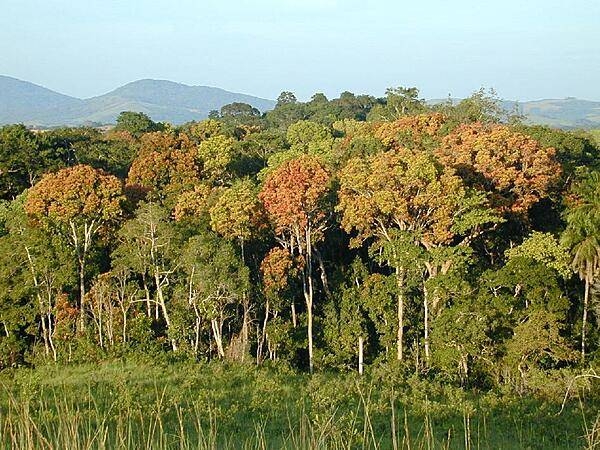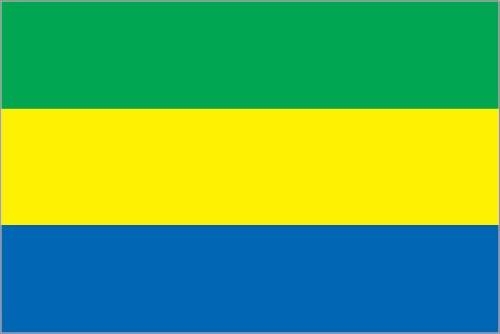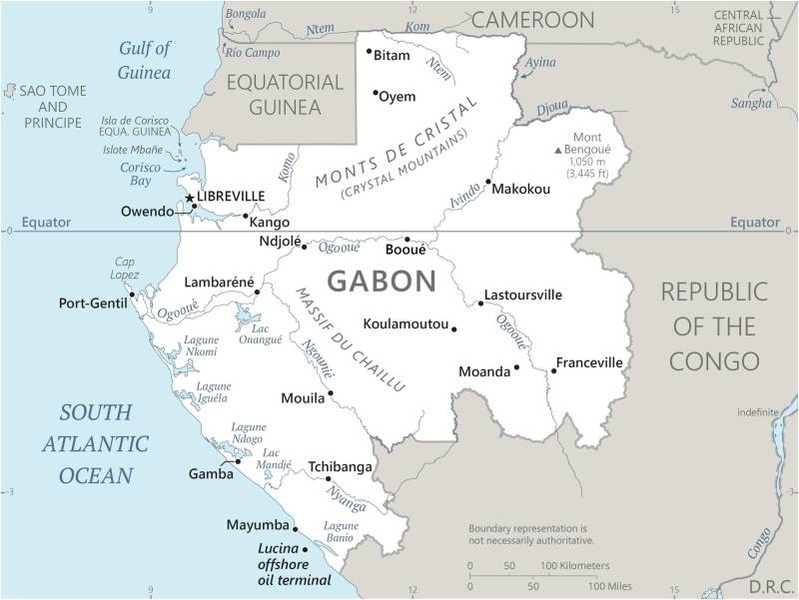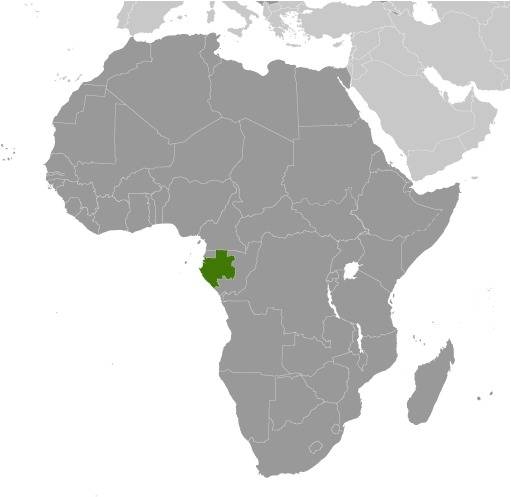Introduction
Background
Gabon, a sparsely populated country known for its dense rainforests and vast petroleum reserves, is one of the most prosperous and stable countries in central Africa. Approximately 40 ethnic groups are represented, the largest of which is the Fang, a group that covers the northern third of Gabon and expands north into Equatorial Guinea and Cameroon. From about the early 1300s, various kingdoms emerged in and surrounding present-day Gabon, including the Kingdoms of Loango and Orungu. Because most early Bantu languages spoken in these kingdoms did not have a written form, historical traditions were passed on orally, resulting in much of Gabon's early history being lost over time. Portuguese traders who arrived in the mid-1400s gave the area its name of Gabon. At that time, indigenous trade networks began to engage with European traders, exchanging goods such as ivory and wood. For a century beginning in the 1760s, trade came to focus mostly on enslaved people. While many groups in Gabon participated in the slave trade, the Fang were a notable exception. As the slave trade declined in the late 1800s, France colonized the country and directed a widespread extraction of Gabonese resources. Anti-colonial rhetoric by Gabon’s educated elites increased significantly in the early 1900s, but no widespread rebellion materialized. French decolonization following World War II led to the country’s independence in 1960.
Within a year of independence, the government changed from a parliamentary to a presidential system, and Leon M’BA won the first presidential election in 1961. El Hadj Omar BONGO Ondimba - one of the longest ruling heads of state in history - was M’BA’s vice president and assumed the presidency after M’BA’s death in 1967. BONGO went on to dominate the country's political scene for four decades (1967-2009). In 1968, he declared Gabon a single-party state and created the Parti Democratique Gabonais (PDG), which remains the predominant party in Gabonese politics today. In the early 1990s, he reintroduced a multiparty system under a new constitution after he was confronted with growing political opposition. He was reelected by wide margins in 1995, 1998, 2002, and 2005 against a divided opposition and amidst allegations of fraud. Following President BONGO's death in 2009, a new election brought his son, Ali BONGO Ondimba, to power. President Ali BONGO Ondimba was reelected in 2016 in a close election against a united opposition. Gabon’s Constitutional Court reviewed the contested election results and ruled in his favor.
Visit the Definitions and Notes page to view a description of each topic.
Geography
Location
Central Africa, bordering the Atlantic Ocean at the Equator, between Republic of the Congo and Equatorial Guinea
Geographic coordinates
1 00 S, 11 45 E
Map references
Africa
Area - comparative
slightly smaller than Colorado
Land boundaries
total: 3,261 km
border countries (3): Cameroon 349 km; Republic of the Congo 2,567 km; Equatorial Guinea 345 km
Coastline
885 km
Maritime claims
territorial sea: 12 nm
contiguous zone: 24 nm
exclusive economic zone: 200 nm
Climate
tropical; always hot, humid
Terrain
narrow coastal plain; hilly interior; savanna in east and south
Elevation
highest point: Mont Bengoue 1,050 m
lowest point: Atlantic Ocean 0 m
mean elevation: 377 m
Natural resources
petroleum, natural gas, diamond, niobium, manganese, uranium, gold, timber, iron ore, hydropower
Land use
agricultural land: 19% (2018 est.)
arable land: 1.2% (2018 est.)
permanent crops: 0.6% (2018 est.)
permanent pasture: 17.2% (2018 est.)
forest: 81% (2018 est.)
other: 0% (2018 est.)
Irrigated land
40 sq km (2012)
Major watersheds (area sq km)
Atlantic Ocean drainage: Congo (3,730,881 sq km)
Major aquifers
Congo Basin
Population distribution
the relatively small population is spread in pockets throughout the country; the largest urban center is the capital of Libreville, located along the Atlantic coast in the northwest as shown in this population distribution map
Natural hazards
none
Geography - note
a small population and oil and mineral reserves have helped Gabon become one of Africa's wealthier countries; in general, these circumstances have allowed the country to maintain and conserve its pristine rain forest and rich biodiversity
People and Society
Nationality
noun: Gabonese (singular and plural)
adjective: Gabonese
Ethnic groups
Gabonese-born 80.1% (includes Fang 23.2%, Shira-Punu/Vili 18.9%, Nzabi-Duma 11.3%, Mbede-Teke 6.9%, Myene 5%, Kota-Kele 4.9%, Okande-Tsogo 2.1%, Pygmy .3%, other 7.5%), Cameroonian 4.6%, Malian 2.4%, Beninese 2.1%, acquired Gabonese nationality 1.6%, Togolese 1.6%, Senegalese 1.1%, Congolese (Brazzaville) 1%, other 5.5% (includes Congolese (Kinshasa), Equatorial Guinean, Nigerian) (2012 est.)
Languages
French (official), Fang, Myene, Nzebi, Bapounou/Eschira, Bandjabi
Religions
Roman Catholic 42.3%, Protestant 12.3%, other Christian 27.4%, Muslim 9.8%, animist 0.6%, other 0.5%, none/no answer 7.1% (2012 est.)
Demographic profile
Gabon’s oil revenues have given it one of the highest per capita income levels in Sub-Saharan Africa, but the wealth is not evenly distributed and poverty is widespread. Unemployment is especially prevalent among the large youth population; more than 60% of the population is under the age of 25. With a fertility rate still averaging more than 4 children per woman, the youth population will continue to grow and further strain the mismatch between Gabon’s supply of jobs and the skills of its labor force.
Gabon has been a magnet to migrants from neighboring countries since the 1960s because of the discovery of oil, as well as the country’s political stability and timber, mineral, and natural gas resources. Nonetheless, income inequality and high unemployment have created slums in Libreville full of migrant workers from Senegal, Nigeria, Cameroon, Benin, Togo, and elsewhere in West Africa. In 2011, Gabon declared an end to refugee status for 9,500 remaining Congolese nationals to whom it had granted asylum during the Republic of the Congo’s civil war between 1997 and 2003. About 5,400 of these refugees received permits to reside in Gabon.
Age structure
0-14 years: 36.45% (male 413,883/female 399,374)
15-24 years: 21.9% (male 254,749/female 233,770)
25-54 years: 32.48% (male 386,903/female 337,776)
55-64 years: 5.19% (male 58,861/female 56,843)
65 years and over: 3.98% (male 44,368/female 44,381) (2020 est.)
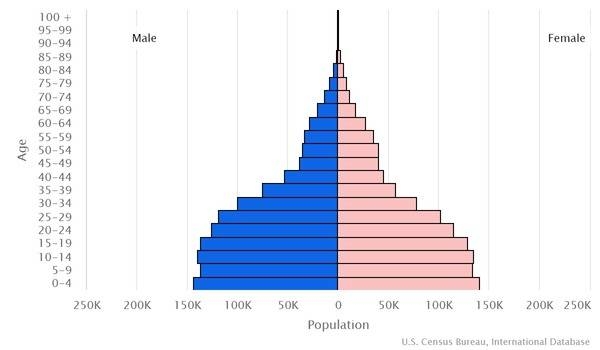
Dependency ratios
total dependency ratio: 67.6
youth dependency ratio: 61
elderly dependency ratio: 6.5
potential support ratio: 15.3 (2021 est.)
Median age
total: 21 years
male: 21.4 years
female: 20.6 years (2020 est.)
Population distribution
the relatively small population is spread in pockets throughout the country; the largest urban center is the capital of Libreville, located along the Atlantic coast in the northwest as shown in this population distribution map
Urbanization
urban population: 91% of total population (2023)
rate of urbanization: 2.27% annual rate of change (2020-25 est.)
Major urban areas - population
870,000 LIBREVILLE (capital) (2023)
Sex ratio
at birth: 1.03 male(s)/female
0-14 years: 1.03 male(s)/female
15-24 years: 1.08 male(s)/female
25-54 years: 1.12 male(s)/female
55-64 years: 1 male(s)/female
65 years and over: 0.78 male(s)/female
total population: 1.08 male(s)/female (2022 est.)
Mother's mean age at first birth
19.6 years (2012 est.)
note: data represents median age at first birth among women 20-49
Maternal mortality ratio
252 deaths/100,000 live births (2017 est.)
country comparison to the world: 41Infant mortality rate
total: 28.56 deaths/1,000 live births
male: 31.58 deaths/1,000 live births
female: 25.46 deaths/1,000 live births (2022 est.)
Life expectancy at birth
total population: 69.7 years
male: 67.98 years
female: 71.48 years (2022 est.)
Contraceptive prevalence rate
31.1% (2012)
Drinking water source
improved: urban: 97.2% of population
rural: 55.3% of population
total: 93.1% of population
unimproved: urban: 2.8% of population
rural: 44.7% of population
total: 6.9% of population (2020 est.)
Current health expenditure
2.8% of GDP (2019)
Physicians density
0.65 physicians/1,000 population (2018)
Hospital bed density
6.3 beds/1,000 population
Sanitation facility access
improved: urban: 81.3% of population
rural: 55.1% of population
total: 78.7% of population
unimproved: urban: 18.7% of population
rural: 44.9% of population
total: 21.3% of population (2020 est.)
Major infectious diseases
degree of risk: very high (2020)
food or waterborne diseases: bacterial diarrhea, hepatitis A, and typhoid fever
vectorborne diseases: malaria and dengue fever
water contact diseases: schistosomiasis
animal contact diseases: rabies
Alcohol consumption per capita
total: 6.47 liters of pure alcohol (2019 est.)
beer: 5.31 liters of pure alcohol (2019 est.)
wine: 0.62 liters of pure alcohol (2019 est.)
spirits: 0.5 liters of pure alcohol (2019 est.)
other alcohols: 0.04 liters of pure alcohol (2019 est.)
Literacy
definition: age 15 and over can read and write
total population: 84.7%
male: 85.9%
female: 83.4% (2018)
Environment
Environment - current issues
deforestation (the forests that cover three-quarters of the country are threatened by excessive logging); burgeoning population exacerbating disposal of solid waste; oil industry contributing to water pollution; wildlife poaching
Environment - international agreements
party to: Biodiversity, Climate Change, Climate Change-Kyoto Protocol, Climate Change-Paris Agreement, Comprehensive Nuclear Test Ban, Desertification, Endangered Species, Hazardous Wastes, Law of the Sea, Marine Dumping-London Convention, Nuclear Test Ban, Ozone Layer Protection, Ship Pollution, Tropical Timber 2006, Wetlands, Whaling
signed, but not ratified: none of the selected agreements
Air pollutants
particulate matter emissions: 38.51 micrograms per cubic meter (2016 est.)
carbon dioxide emissions: 5.32 megatons (2016 est.)
methane emissions: 1.13 megatons (2020 est.)
Climate
tropical; always hot, humid
Land use
agricultural land: 19% (2018 est.)
arable land: 1.2% (2018 est.)
permanent crops: 0.6% (2018 est.)
permanent pasture: 17.2% (2018 est.)
forest: 81% (2018 est.)
other: 0% (2018 est.)
Urbanization
urban population: 91% of total population (2023)
rate of urbanization: 2.27% annual rate of change (2020-25 est.)
Revenue from forest resources
forest revenues: 2.6% of GDP (2018 est.)
country comparison to the world: 26Major infectious diseases
degree of risk: very high (2020)
food or waterborne diseases: bacterial diarrhea, hepatitis A, and typhoid fever
vectorborne diseases: malaria and dengue fever
water contact diseases: schistosomiasis
animal contact diseases: rabies
Waste and recycling
municipal solid waste generated annually: 238,102 tons (1995 est.)
Major watersheds (area sq km)
Atlantic Ocean drainage: Congo (3,730,881 sq km)
Major aquifers
Congo Basin
Total water withdrawal
municipal: 84.7 million cubic meters (2017 est.)
industrial: 14.1 million cubic meters (2017 est.)
agricultural: 40.3 million cubic meters (2017 est.)
Total renewable water resources
166 billion cubic meters (2017 est.)
Government
Country name
conventional long form: Gabonese Republic
conventional short form: Gabon
local long form: Republique Gabonaise
local short form: Gabon
etymology: name originates from the Portuguese word "gabao" meaning "cloak," which is roughly the shape that the early explorers gave to the estuary of the Komo River by the capital of Libreville
Government type
presidential republic
Capital
name: Libreville
geographic coordinates: 0 23 N, 9 27 E
time difference: UTC+1 (6 hours ahead of Washington, DC, during Standard Time)
etymology: original site settled by freed slaves and the name means "free town" in French; named in imitation of Freetown, the capital of Sierra Leone
Administrative divisions
9 provinces; Estuaire, Haut-Ogooue, Moyen-Ogooue, Ngounie, Nyanga, Ogooue-Ivindo, Ogooue-Lolo, Ogooue-Maritime, Woleu-Ntem
Independence
17 August 1960 (from France)
National holiday
Independence Day, 17 August (1960)
Constitution
history: previous 1961; latest drafted May 1990, adopted 15 March 1991, promulgated 26 March 1991
amendments: proposed by the president of the republic, by the Council of Ministers, or by one third of either house of Parliament; passage requires Constitutional Court evaluation, at least two-thirds majority vote of two thirds of the Parliament membership convened in joint session, and approval in a referendum; constitutional articles on Gabon’s democratic form of government cannot be amended; amended several times, last in 2020
Legal system
mixed legal system of French civil law and customary law
International law organization participation
has not submitted an ICJ jurisdiction declaration; accepts ICCt jurisdiction
Citizenship
citizenship by birth: no
citizenship by descent only: at least one parent must be a citizen of Gabon
dual citizenship recognized: no
residency requirement for naturalization: 10 years
Suffrage
18 years of age; universal
Executive branch
chief of state: President Ali BONGO Ondimba (since 16 October 2009)
head of government: Prime Minister Rose Christiane Ossouka RAPONDA (since 16 July 2020)
cabinet: Council of Ministers appointed by the prime minister in consultation with the president
elections/appointments: president directly elected by simple majority popular vote for a 7-year term (no term limits); election last held on 27 August 2016 (next to be held in August 2023); prime minister appointed by the president
election results: Ali BONGO Ondimba reelected president; percent of vote - Ali BONGO Ondimba (PDG) 49.8%, Jean PING (UFC) 48.2%, other 2.0% (2016)
Legislative branch
description: bicameral Parliament or Parlement consists of:
Senate or Senat (102 seats; members indirectly elected by municipal councils and departmental assemblies by absolute majority vote in 2 rounds if needed; members serve 6-year terms)
National Assembly or Assemblee Nationale (143 seats; members elected in single-seat constituencies by absolute majority vote in 2 rounds if needed; members serve 5-year terms)
elections:
Senate - last held on 30 January and 6 February 2021 (next to be held in December 2026)
National Assembly - held in 2 rounds on 6 and 27 October 2018 (next to be held in 2023)
election results:
Senate - percent of vote by party - NA; seats by party - PDG 81, CLR 7, PSD 2, ADERE-UPG 1, UPG 1, PGCI 1, independent 7; composition - NA
National Assembly - percent of vote by party - NA; seats by party - PDG 98, The Democrats or LD 11, RV 8, Social Democrats of Gabon 5, RH&M 4, other 9, independent 8; composition - men 121, women 22, percent of women 15.4%; note - total Parliament percent of women NA
Judicial branch
highest court(s): Supreme Court (consists of 4 permanent specialized supreme courts - Supreme Court or Cour de Cassation, Administrative Supreme Court or Conseil d'Etat, Accounting Supreme Court or Cour des Comptes, Constitutional Court or Cour Constitutionnelle, and the non-permanent Court of State Security, initiated only for cases of high treason by the president and criminal activity by executive branch officials)
judge selection and term of office: appointment and tenure of Supreme, Administrative, Accounting, and State Security courts NA; Constitutional Court judges appointed - 3 by the national president, 3 by the president of the Senate, and 3 by the president of the National Assembly; judges serve single renewable 7-year terms
subordinate courts: Courts of Appeal; county courts; military courts
Political parties and leaders
Circle of Liberal Reformers or CLR [Gen. Jean-Boniface ASSELE]
Democratic and Republican Alliance or ADERE [DIDJOB Divungui di Ndinge]
Gabonese Democratic Party or PDG [Ali BONGO Ondimba]
Independent Center Party of Gabon or PGCI [Luccheri GAHILA]
Legacy and Modernity Party or RH&M
National Woodcutters' Rally - Rally for Gabon or RNB-RPG [Paul Mba ABESSOLE]
Restoration of Republican Values or RV
Social Democratic Party or PSD [Pierre Claver MAGANGA-MOUSSAVOU]
Social Democrats of Gabon
The Democrats or LD [Guy NZOUBA-NDAMA]
Union for the New Republic or UPRN [Louis Gaston MAYILA]
Union of Forces for Change or UFC [Jean PING]
Union of Gabonese People or UPG [Richard MOULOMBA]
Paul Mba Abessole
International organization participation
ACP, AfDB, AU, BDEAC, CEMAC, FAO, FZ, G-24, G-77, IAEA, IBRD, ICAO, ICCt, ICRM, IDA, IDB, IFAD, IFC, IFRCS, ILO, IMF, IMO, IMSO, Interpol, IOC, IOM, IPU, ISO, ITSO, ITU, ITUC (NGOs), MIGA, NAM, OIC, OIF, OPCW, UN, UNCTAD, UNESCO, UNHRC, UNIDO, UNWTO, UPU, WCO, WHO, WIPO, WMO, WTO
Diplomatic representation in the US
chief of mission: Charge D'Affaires Rod Ciangillan REMBENDAMBYA, Counselor (17 March 2021)
chancery: 2034 20th Street NW, Suite 200, Washington, DC 20009
telephone: [1] (202) 797-1000
FAX: [1] (301) 332-0668
email address and website:
info@gaboneembassyusa.org
https://gabonembassyusa.org/en/
Diplomatic representation from the US
chief of mission: Ambassador (vacant); Charge d'Affaires Samuel R. WATSON; note - also accredited to Sao Tome and Principe
embassy: Sabliere, B.P. 4000, Libreville
mailing address: 2270 Libreville Place, Washington, DC 20521-2270
telephone: [241] 011-45-71-00
FAX: [241] 011-45-71-05
email address and website:
ACSLibreville@state.gov
https://ga.usembassy.gov/
Flag description
three equal horizontal bands of green (top), yellow, and blue; green represents the country's forests and natural resources, gold represents the equator (which transects Gabon) as well as the sun, blue represents the sea
National symbol(s)
black panther; national colors: green, yellow, blue
National anthem
name: "La Concorde" (The Concorde)
lyrics/music: Georges Aleka DAMAS
note: adopted 1960
National heritage
total World Heritage Sites: 2 (1 natural, 1 mixed)
selected World Heritage Site locales: Ecosystem and Relict Cultural Landscape of Lopé-Okanda (m); Ivindo National Park (n)
Economy
Economic overview
Gabon enjoys a per capita income four times that of most Sub-Saharan African nations, but because of high income inequality, a large proportion of the population remains poor. Gabon relied on timber and manganese exports until oil was discovered offshore in the early 1970s. From 2010 to 2016, oil accounted for approximately 80% of Gabon’s exports, 45% of its GDP, and 60% of its state budget revenues.
Gabon faces fluctuating international prices for its oil, timber, and manganese exports. A rebound of oil prices from 2001 to 2013 helped growth, but declining production, as some fields passed their peak production, has hampered Gabon from fully realizing potential gains. GDP grew nearly 6% per year over the 2010-14 period, but slowed significantly from 2014 to just 1% in 2017 as oil prices declined. Low oil prices also weakened government revenue and negatively affected the trade and current account balances. In the wake of lower revenue, Gabon signed a 3-year agreement with the IMF in June 2017.
Despite an abundance of natural wealth, poor fiscal management and over-reliance on oil has stifled the economy. Power cuts and water shortages are frequent. Gabon is reliant on imports and the government heavily subsidizes commodities, including food, but will be hard pressed to tamp down public frustration with unemployment and corruption.
Real GDP (purchasing power parity)
$32.05 billion (2020 est.)
$32.48 billion (2019 est.)
$31.25 billion (2018 est.)
note: data are in 2017 dollars
Real GDP growth rate
0.5% (2017 est.)
2.1% (2016 est.)
3.9% (2015 est.)
Real GDP per capita
$14,400 (2020 est.)
$15,000 (2019 est.)
$14,700 (2018 est.)
note: data are in 2017 dollars
GDP (official exchange rate)
$16.064 billion (2019 est.)
Inflation rate (consumer prices)
2.4% (2019 est.)
4.7% (2018 est.)
2.6% (2017 est.)
Credit ratings
Fitch rating: CCC (2020)
Moody's rating: Caa1 (2018)
Standard & Poors rating: N/A (2016)
note: The year refers to the year in which the current credit rating was first obtained.
GDP - composition, by sector of origin
agriculture: 5% (2017 est.)
industry: 44.7% (2017 est.)
services: 50.4% (2017 est.)
GDP - composition, by end use
household consumption: 37.6% (2017 est.)
government consumption: 14.1% (2017 est.)
investment in fixed capital: 29% (2017 est.)
investment in inventories: -0.6% (2016 est.)
exports of goods and services: 46.7% (2017 est.)
imports of goods and services: -26.8% (2017 est.)
Agricultural products
plantains, cassava, sugar cane, yams, taro, vegetables, maize, groundnuts, game meat, rubber
Industries
petroleum extraction and refining; manganese, gold; chemicals, ship repair, food and beverages, textiles, lumbering and plywood, cement
Labor force - by occupation
agriculture: 64%
industry: 12%
services: 24% (2005 est.)
Population below poverty line
33.4% (2017 est.)
Gini Index coefficient - distribution of family income
38 (2017 est.)
country comparison to the world: 74Household income or consumption by percentage share
lowest 10%: 2.5%
highest 10%: 32.7% (2005)
Budget
revenues: 2.634 billion (2017 est.)
expenditures: 2.914 billion (2017 est.)
Fiscal year
calendar year
Current account balance
-$725 million (2017 est.)
-$1.389 billion (2016 est.)
Exports
$10.8 billion (2019 est.)
$9.533 billion (2018 est.)
$9.145 billion (2017 est.)
Exports - partners
China 63%, Singapore 5% (2019)
Exports - commodities
crude petroleum, manganese, lumber, veneer sheeting, refined petroleum (2019)
Imports
$5.02 billion (2019 est.)
$4.722 billion (2018 est.)
$4.749 billion (2017 est.)
Imports - partners
France 22%, China 17%, Belgium 6%, United States 6%, United Arab Emirates 5% (2019)
Imports - commodities
poultry meats, excavation machinery, packaged medicines, cars, rice (2019)
Reserves of foreign exchange and gold
$981.6 million (31 December 2017 est.)
$804.1 million (31 December 2016 est.)
Debt - external
$6.49 billion (31 December 2017 est.)
$5.321 billion (31 December 2016 est.)
Exchange rates
Cooperation Financiere en Afrique Centrale francs (XAF) per US dollar -
605.3 (2017 est.)
593.01 (2016 est.)
593.01 (2015 est.)
591.45 (2014 est.)
494.42 (2013 est.)
Energy
Electricity access
electrification - total population: 92% (2019)
electrification - urban areas: 99% (2019)
electrification - rural areas: 39% (2019)
Electricity
installed generating capacity: 784,000 kW (2020 est.)
consumption: 3.134 billion kWh (2019 est.)
exports: 0 kWh (2019 est.)
imports: 511 million kWh (2019 est.)
transmission/distribution losses: 389 million kWh (2019 est.)
Electricity generation sources
fossil fuels: 40.6% of total installed capacity (2020 est.)
nuclear: 0% of total installed capacity (2020 est.)
solar: 0.1% of total installed capacity (2020 est.)
wind: 0% of total installed capacity (2020 est.)
hydroelectricity: 59% of total installed capacity (2020 est.)
tide and wave: 0% of total installed capacity (2020 est.)
geothermal: 0% of total installed capacity (2020 est.)
biomass and waste: 0.3% of total installed capacity (2020 est.)
Coal
production: 0 metric tons (2020 est.)
consumption: 0 metric tons (2020 est.)
exports: 0 metric tons (2020 est.)
imports: 0 metric tons (2020 est.)
proven reserves: 0 metric tons (2019 est.)
Petroleum
total petroleum production: 175,000 bbl/day (2021 est.)
refined petroleum consumption: 14,400 bbl/day (2019 est.)
crude oil and lease condensate exports: 178,400 bbl/day (2018 est.)
crude oil and lease condensate imports: 0 bbl/day (2018 est.)
crude oil estimated reserves: 2 billion barrels (2021 est.)
Refined petroleum products - production
16,580 bbl/day (2017 est.)
country comparison to the world: 91Natural gas
production: 319.102 million cubic meters (2019 est.)
consumption: 319.102 million cubic meters (2019 est.)
exports: 0 cubic meters (2021 est.)
imports: 0 cubic meters (2021 est.)
proven reserves: 25.995 billion cubic meters (2021 est.)
Carbon dioxide emissions
2.651 million metric tonnes of CO2 (2019 est.)
from coal and metallurgical coke: 0 metric tonnes of CO2 (2019 est.)
from petroleum and other liquids: 2.025 million metric tonnes of CO2 (2019 est.)
from consumed natural gas: 626,000 metric tonnes of CO2 (2019 est.)
Energy consumption per capita
26.786 million Btu/person (2019 est.)
country comparison to the world: 127Communications
Telephones - fixed lines
total subscriptions: 25,428 (2020 est.)
subscriptions per 100 inhabitants: 1 (2020 est.)
Telephones - mobile cellular
total subscriptions: 3,049,530 (2020 est.)
subscriptions per 100 inhabitants: 137 (2020 est.)
Telecommunication systems
general assessment: the telecom market was liberalized in 1999 when the government awarded three mobile telephony licenses and two ISP licenses and established an independent regulatory authority; in contrast with the mobile market, Gabon’s fixed-line and internet sectors have remained underdeveloped due to a lack of competition and high prices; the country has sufficient international bandwidth on the SAT-3/WASC/SAFE submarine cable; the arrival of the ACE submarine cable, combined with progressing work on the CAB cable, has increased back haul capacity supporting mobile data traffic (2022)
domestic: fixed-line is a little over 1 per 100 subscriptions; a growing mobile cellular network with multiple providers is making telephone service more widely available with mobile cellular teledensity at nearly 139 per 100 persons (2020)
international: country code - 241; landing points for the SAT-3/WASC, ACE and Libreville-Port Gentil Cable fiber-optic submarine cable that provides connectivity to Europe and West Africa; satellite earth stations - 3 Intelsat (Atlantic Ocean) (2019)
note: the COVID-19 pandemic continues to have a significant impact on production and supply chains globally; since 2020, some aspects of the telecom sector have experienced a downturn, particularly in mobile device production; progress toward 5G implementation has resumed, as well as upgrades to infrastructure; consumer spending on telecom services has increased due to the surge in demand for capacity and bandwidth; the crucial nature of telecom services as a tool for work and school from home is still evident, and the spike in this area has seen growth opportunities for development of new tools and increased services
Broadcast media
state owns and operates 2 TV stations and 2 radio broadcast stations; a few private radio and TV stations; transmissions of at least 2 international broadcasters are accessible; satellite service subscriptions are available
Internet users
total: 1,379,951 (2020 est.)
percent of population: 62% (2020 est.)
Broadband - fixed subscriptions
total: 44,607 (2020 est.)
subscriptions per 100 inhabitants: 2 (2020 est.)
Transportation
National air transport system
number of registered air carriers: 3 (2020)
inventory of registered aircraft operated by air carriers: 8
Airports - with paved runways
total: 14
over 3,047 m: 1
2,438 to 3,047 m: 2
1,524 to 2,437 m: 9
914 to 1,523 m: 1
under 914 m: 1 (2021)
Airports - with unpaved runways
total: 30
1,524 to 2,437 m: 7
914 to 1,523 m: 9 (2013)
under 914 m: 14 (2021)
Pipelines
807 km gas, 1,639 km oil, 3 km water (2013)
Railways
total: 649 km (2014)
standard gauge: 649 km (2014) 1.435-m gauge
Roadways
total: 14,300 km (2001)
paved: 900 km (2001)
unpaved: 13,400 km (2001)
Merchant marine
total: 62
by type: bulk carrier 1, general cargo 17, oil tanker 17, other 27 (2021)
Ports and terminals
major seaport(s): Libreville, Owendo, Port-Gentil
oil terminal(s): Gamba, Lucina
Military and Security
Military and security forces
Gabonese Armed Forces (Force Armées Gabonaise or FAG; aka Gabonese Defense and Security Forces): Land Forces (Army), National Navy, Air Force, National Gendarmerie (includes Coast Guard), Corps of Firemen; Republican Guard (2022)
note: the National Police Forces, under the Ministry of Interior, and the National Gendarmerie, under the Ministry of Defense, are responsible for law enforcement and public security; elements of the armed forces and the Republican Guard, an elite unit that protects the president under his direct authority, sometimes performed internal security functions
Military expenditures
1.7% of GDP (2021 est.)
1.8% of GDP (2020 est.)
1.6% of GDP (2019 est.) (approximately $450 million)
1.6% of GDP (2018 est.) (approximately $440 million)
1.8% of GDP (2017 est.) (approximately $480 million)
Military and security service personnel strengths
approximately 6,500 active duty troops including the Republican Guard and Gendarmerie (2022)
Military equipment inventories and acquisitions
the Gabonese military is lightly armed with a mixed inventory from a variety of suppliers; since 2010, providers have included Brazil, China, France, Germany, and South Africa (2021)
Military service age and obligation
20 years of age for voluntary military service; no conscription (2021)
Military - note
members of the Gabonese Defense Forces attempted a failed coup in January 2019
Maritime threats
the International Maritime Bureau reports the territorial and offshore waters in the Niger Delta and Gulf of Guinea remain a very high risk for piracy and armed robbery of ships; in 2021, there were 34 reported incidents of piracy and armed robbery at sea in the Gulf of Guinea region; although a significant decrease from the total number of 81 incidents in 2020, it included the one hijacking and three of five ships fired upon worldwide; while boarding and attempted boarding to steal valuables from ships and crews are the most common types of incidents, almost a third of all incidents involve a hijacking and/or kidnapping; in 2021, 57 crew members were kidnapped in seven separate incidents in the Gulf of Guinea, representing 100% of kidnappings worldwide; Nigerian pirates in particular are well armed and very aggressive, operating as far as 200 nm offshore; the Maritime Administration of the US Department of Transportation has issued a Maritime Advisory (2022-001 - Gulf of Guinea-Piracy/Armed Robbery/Kidnapping for Ransom) effective 4 January 2022, which states in part, "Piracy, armed robbery, and kidnapping for ransom continue to serve as significant threats to US-flagged vessels transiting or operating in the Gulf of Guinea"
Transnational Issues
Disputes - international
UN urges Equatorial Guinea and Gabon to resolve the sovereignty dispute over Gabon-occupied Mbane Island and lesser islands and to establish a maritime boundary in hydrocarbon-rich Corisco Bay
